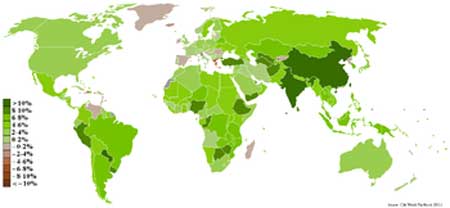
Is economic growth sustainable? Is it a goal we should even aspire to? What is going on in the global economy?
Two very interesting and radically different perspectives are personified by Richard Heinberg and Hans Rosling. Basically Heinberg sees economic growth as dependent on oil, and as oil production diminishes in a post peak oil world global economic contraction is inevitable. Hans Rosling takes a much more positive and optimistic view, seeing overcoming global poverty and ensuring sustainable prosperity for all as a very achievable goal. I’m with Rosling on this one. It is interesting that Heinberg comes from economically fragile, debt ridden, oil obsessed, end of empire USA, while Rosling comes from economically booming and renewables pioneering Sweden.
Of course many of us in the west reached material saturation years ago, and for us more money and possessions are not a sound basis for happiness. A certain degree of frugality and sharing resources is more fun than the social isolation of excessive greed. However few of us really want to live in poverty. Rosling and I, unlike Heinberg, would argue that a Swedish level of prosperity for all the people of the world is an attainable and sustainable goal.
Meanwhile, what is actually going on in the global economy? It is a very mixed picture. Some industries are in terminal decline while others, especially renewables are absolutely booming. Debt ridden Greece is contracting and the USA is only a little better.
Meanwhile many countries are booming, for all manner of reasons, some sustainable, some not. Qatar is booming through oil and gas exports, Paraguay and Argentina through beef and Ethiopia through coffee and sesame exports to China and India. The most interesting example is Singapore. It has no natural resources, except a good harbour, yet has overcome poverty and has more millionaire households per head of population than anywhere else on earth and possibly the world’s best health care system.
Watch Hans Rosling’s amazing and positive 4 minute video clip of 200 years of global economic history http://www.youtube.com/watch?v=jbkSRLYSojo
By contrast see Heinberg http://www.energybulletin.net/stories/2011-07-23/review-end-growth-richard-heinberg
Note that the top 100 performing countries (judged by GDP, with all its weaknesses) are nearly all from the old ‘global south’. See List of Countries by real GDP growth rate
Monthly Archives: July 2011
Italy: energy and emissions



In the referendum on 12th June Italians voted to reject nuclear power, by a majority of 94%, scuppering Berlusconi’s plans for a major expansion of nuclear. They join Germany, Switzerland and others in quitting nuclear power. Currently Italy relies heavily on energy imports, of oil, gas and electricity, and this decision could increase this trend. However the good news is that Italy is moving ahead rapidly with renewables, as the graphs for solar and wind show.
The Italian photovoltaics sector has been booming since 2007, partly due to generous feed in tariffs. The dramatic effect of these can be seen in the middle graph above. Some reports say Italy is currently second only to Germany in terms of installed capacity, and catching up as Germany cuts back on feed in tariffs. In terms of concentrating solar power Italy is a long way behind Spain, but it did open the small but impressive Archimede plant in Sicily last year.
Currently Italy gets most of its renewable electricity from hydro power. This is unlikely to be able to expand very much due to the limited number of possible locations. Italy has good geothermal potential. In 1911 it opened the world’s first geothermal power station at Larderello in Southern Tuscany. Currently it has 843 MW of installed geothermal capacity, ranking it at number five in the world. It recently opened a new 20 MW facility in Tuscany. There appears to be considerable scope for further expansion. Wind power is expanding rapidly, and looks set to continue to do so, as the bottom graph shows.
Italy currently has the highest electricity prices in Europe, which may be bad news for consumers but is good news from a sustainability point of view. It means the payback times on energy efficiency and renewables are quicker than in places with lower electricity prices.
Italian per capita carbon emissions from energy use appear to have peaked in 2003 at over 8 tonnes, and now are slowly beginning to fall. They have a long way to go before the Italian economy could be said to be sustainable, and renewables are still a small percentage of total electricity generation, but let’s celebrate with the Italian people their commitment to renewables and falling Co2 emissions.
Lots more data on Italian energy issues here http://www.tititudorancea.com/z/ies_italy_carbon_dioxide_emissions_per_capita.htm
Italian Referendum http://www.bbc.co.uk/news/world-europe-13741105
